US Apparel Requirements: Adult and children’s apparel
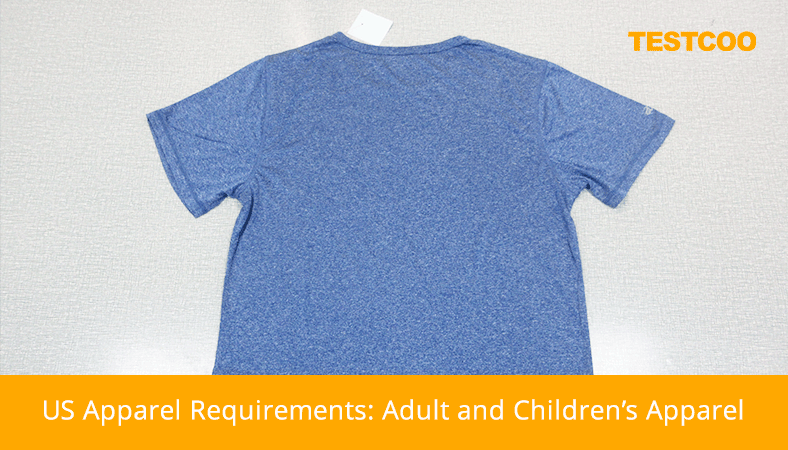 Sell clothes in America? What is required for adult and children apparel to keep quality assurance? The CPSC is a federal government agency charged with protecting the public from unreasonable risks of injury or death associated with the use of consumer products under the agency's jurisdiction.
Sell clothes in America? What is required for adult and children apparel to keep quality assurance? The CPSC is a federal government agency charged with protecting the public from unreasonable risks of injury or death associated with the use of consumer products under the agency's jurisdiction.
The CPSIA requires that adult apparel and children's sleepwear must comply with relevant standards, substance restrictions, and other rules before importing or selling a product.
Selling unsafe and non-compliant products is not only a severe risk for the consumers in your target market, but also something that can massively backfire on your own business. Your products may be subject to a forced recall.
Flammable Fabrics Act (FFA)
↵
Flammable Fabrics Act (FFA) is the primary authority for CPSC-regulated textiles and focus on flammability performance.
Under FFA, CPSC can and has issued standards. The quality control standards for clothing textiles, vinyl plastic film used in clothes, carpets and rugs, children’s sleepwear, mattresses and mattress pads:
- Clothing Textiles: 16 CFR part 1610
- Vinyl plastic film: 16 CFR part 1611
- Children’s sleepwear: 16 CFR parts 1615/1616
- Carpets and rugs: 16 CFR parts 1630/1631
- Mattresses and mattress pads: 16 CFR part 1632
- Mattress sets: 16 CFR part 1633
Scope of Apparel Quality Inspection Requirements
1. Clothing Textiles: 16 CFR part 1610
Applies to: All textiles used for adult and children’s wearing apparel.
Does not apply to: The following items do not require flammability testing to 16 CFR part 1610:
- Hats that do not form part of a covering for the neck, face, or shoulders;
- Gloves, provided they are not more than 14 inches in length and are not affixed to or do not form an integral part of another garment;
- Footwear, provided it does not consist of hosiery and is not affixed to or does not form an integral part of another garment;
- Interlining fabrics, when intended or sold for use as a layer between an outer shell and an inner lining in wearing apparel.
Some fabrics are exempted from testing requirements:
- All plain-surface fabrics greater than or equal to 88.2 g/m2 (2.6 oz/yd2).
- Any fabric made in whole or with a blend of the following fiber types only: Acrylic, modacrylic, nylon, olefin, polyester, wool.
Classification
Class 1: Plain and raised fiber surface fabrics; no unusual burning characteristics and are acceptable for use in clothing.
Class 2: Raised fiber surface fabrics only; intermediate flammability- use with caution.
Class 3: Plain and raised fiber surface fabrics; fabrics are dangerously flammable and CANNOT be used in wearing apparel.
Common Types of Noncompliant Fabrics:

- Lightweight, sheer fabrics of rayon and silk. Example: Scarves
- Raised fiber surface cellulose or cellulose-blend fabrics. Examples: rayon and rayon-blend chenille, cotton and cotton-blend fleece, cotton terry
Children’s sleepwear must meet a more stringent standard.
2. Vinyl plastic film: 16 CFR part 1611
16 CFR part 1611 regulates the Standard for the Flammability of Vinyl Plastic Film, which applies to non-rigid, unsupported vinyl plastic film, including transparent, translucent, and opaque material used in wearing apparel subject to the FFA. Examples: disposable diapers, raincoats, some costumes. It specifies testing procedures to determine the average burn time of vinyl plastic film.
3. Drawstrings
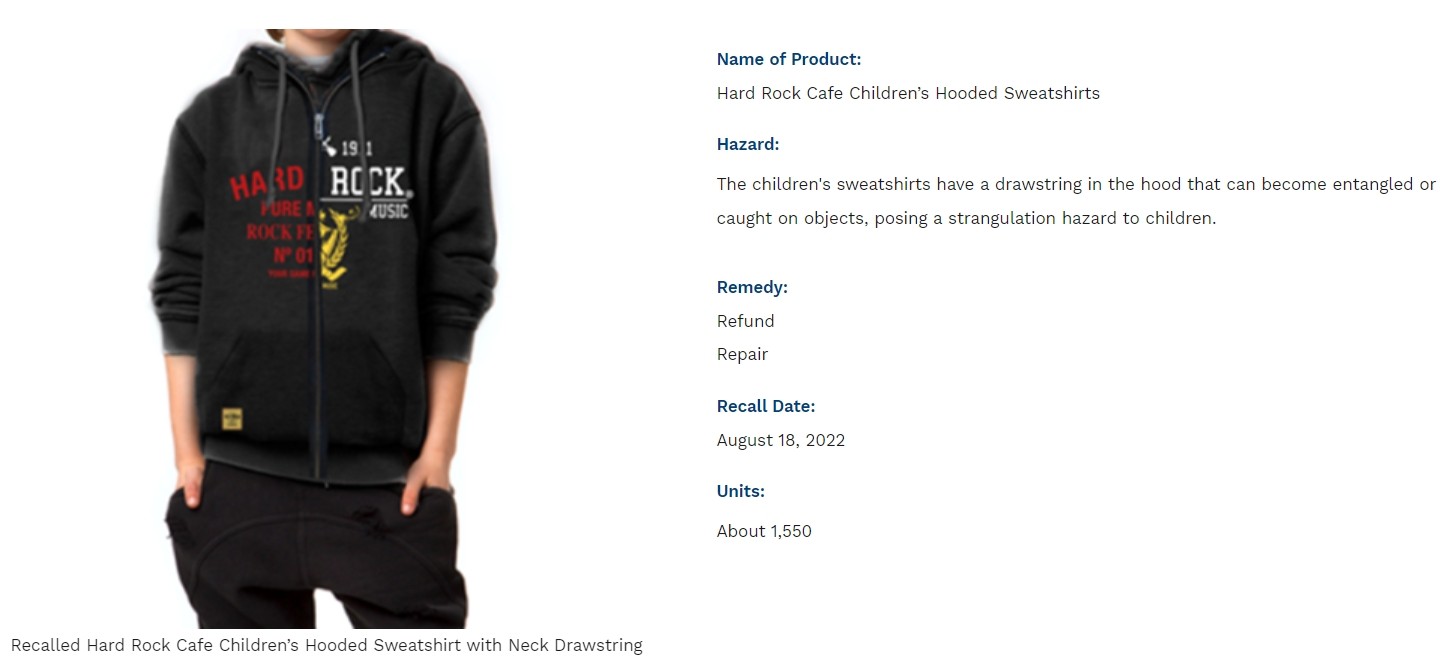
CPSC: hard rock recalls children’s hooded sweatshirts with drawstrings due to strangulation hazard
Applies to drawstrings at the neck or waist on upper outwear.
- Clothing generally intended to be worn on the exterior of other garments (ex. jackets, ski vests, anoraks, and sweatshirts).
- Ties are considered drawstrings and are subject to the requirements.
Does not apply to: Underwear, inner clothing layers, pants, shorts, swimwear, dresses and skirts. These items are not considered upper outerwear.
Belts are not drawstrings and are not subject to the requirements.
Hood and neck area (sizes 2T through 12)
- Not allowed
- Use alternative closures, such as snaps, buttons, Velcro, and elastic.
Waist and bottom drawstrings (sizes 2T to 16): Allowed, but must meet certain requirements:
- Drawstring must not extend more than 3 inches from the channel when the garment is expanded to its fullest width.
- Continuous drawstrings must be bar tacked or stitched through to prevent the drawstring from being pulled through its channel.
- Cord locks, knots, toggles, or other attachments at the free ends of drawstrings are prohibited (even on fully retractable drawstrings).
Hood and neck drawstrings are not allowed on children's upper outerwear in sizes 2T to 12 because they present a strangulation hazard. “Children’s upper outerwear” is defined as clothing, such as jackets and sweatshirts, generally intended to be worn on the exterior of other garments and includes lightweight outerwear that is appropriate for use in warmer climates. Pants, shorts, and skirts are not intended for the upper portion of the body and are excluded from the scope of this standard.
Other CPSC Requirements: Certification, Chemical Content, Tracking Labels, Small Parts
1. Certification
General Use Product
- General Certificate of Conformity (GCC)
- Does not require third party testing
- Applies to adult apparel
To find out more information on a GCC: Apparel Standards and Regulations in the US - A Guide to Compliance
It must accompany the product or product shipment, be furnished to each distributor or retailer, and be made available to the CPSC or U.S. Customs upon request. These requirements are satisfied by either providing an actual hard copy or by providing the CPC electronically. So if you importing apparel to the US, your inspection qc or third-party inspection agency need keep the GCC checking in your pre-shipment inspection checklists.
Children’s Product
- Children’s Product Certificate (CPC)
- Requires third party testing by a CPSC-accepted laboratory for all regulations to which the product is subject
- Applies to all children’s apparel
Manufacturers and importers of children’s products must certify compliance with applicable federal safety requirements in a Children’s Product Certificate (CPC). In most instances, testing by a third-party, CPSC-Accepted Laboratory must serve as the basis for the production of your CPC.
The 7 Elements Required in a CPC:
1) Identification of the product covered by this certificate
2) Citation to each CPSC children’s product safety rule to which this product is being certified
3) The name, full mailing address, and telephone number of the firm.
4) Contact information: the name, full mailing address, e-mail address, and telephone number of the person maintaining test records in support of the certification.
5) Date and place of manufacture
6) Date and place of testing
7) Contact of laboratory: provide at least the name, full mailing address, and telephone number.
2. Chemical Content
↵
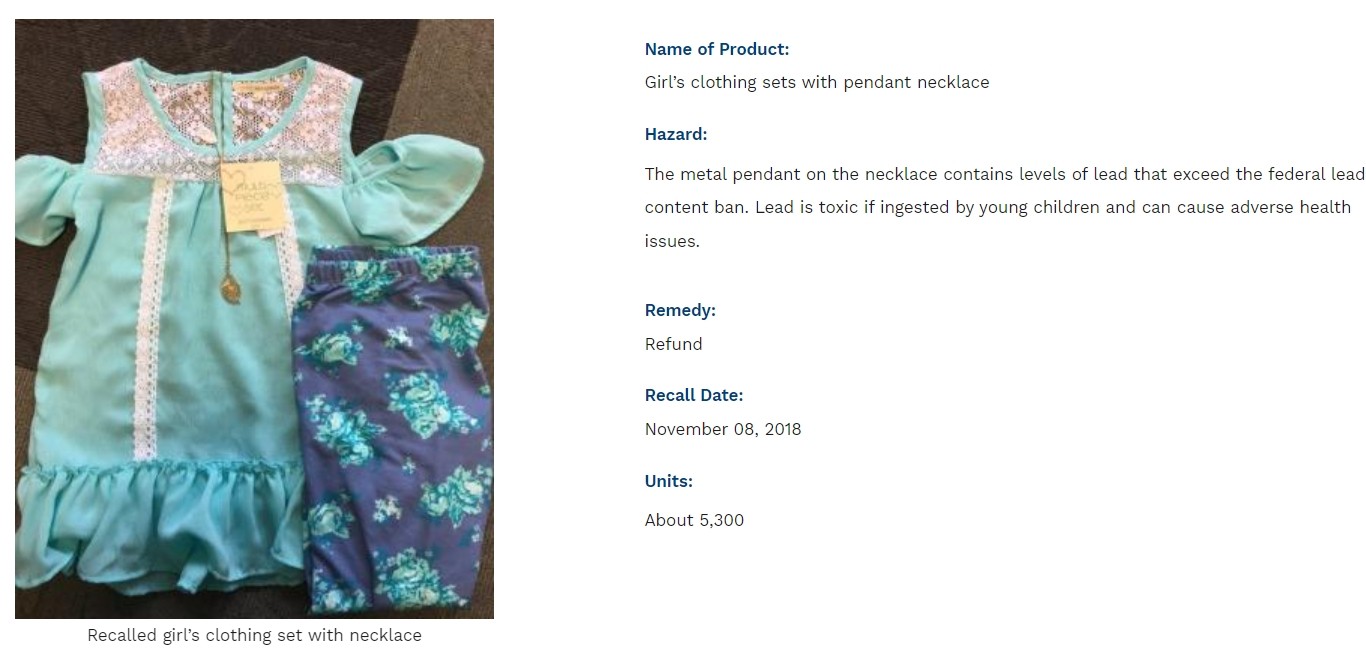
CPSC: h.i.s. recalls girl’s clothing sets due to violation of federal lead content ban
Lead Content (FHSA)
- Products designed and intended primarily for children 12 years or younger
- Concentration may not exceed 100 ppm
- Applies to children’s apparel and sleepwear (zippers, buttons, etc.)
All accessible component parts of a children's product must be tested to demonstrate compliance with the lead content limit of 100 parts per million (ppm). This requirement applies to substrate materials in children’s products, such as metals and plastics. Lead content testing must be conducted at a third party, CPSC-accepted laboratory.
Testing Exemptions: The Commission has determined that certain materials do not need to be tested by a third party laboratory. To rely on the following list, the materials must be untreated and unadulterated, and the product must be made exclusively of the following materials:
- certain natural and synthetic textiles, such as cottons, wools, and polyesters, among others;
- pure wood (not plywood or other composites);
- paper and other similar products made from cellulosic fiber;
- CMYK ink printing processes;
- certain plant-derived and animal-derived materials, such as animal glue, bee's wax, seeds, nut shells, flowers, sea shells, leather;
- certain precious, semi-precious gemstones and pearls; and
- certain stainless steel and precious metals, as listed.
This list is a sampling of the determinations that the Commission has made. You can find the complete list of material determinations at: 16 CFR § 1500.91
Lead in Paint and Surface Coatings (CPSA)
- Products designed and intended primarily for children 12 years or younger and some general use furniture
- Concentration may not exceed 90 ppm
- Applies to children’s general apparel and sleepwear (screen prints)
Phthalate Content (CPSA)
- Children’s toys and child care articles (products used to facilitate sleeping and feeding for children 3 years or younger)
- Only certain phthalates
- Concentration may not exceed 0.1 %
- Applies to children’s sleepwear and some apparel (bibs)
Determinations
Lead
- §1500.91: Certain materials will not exceed lead limits.
- Textiles made from certain fiber types, dyed and undyed (including some prints).
Phthalates
- §1308.2: Certain plastics with specified additives will not exceed the specified phthalates content limits.
- Includes polypropylene and polyethylene.
3. Tracking Labels
↵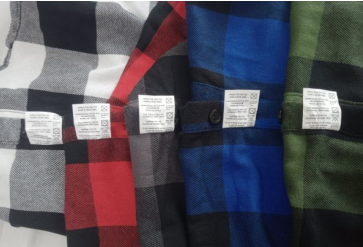
Picture of the care label in the shirt quality inspection report provided by TESTCOO
All children’s products must include permanent tracking information on the product and its packaging, to the extent practicable. For products designed and intended primarily for children 12 years or younger, a permanent, distinguishing mark (tracking label) must:
Be affixed to the product and its packaging, visible and legible.
Provide certain identifying information:
- Manufacturer or private labeler name;
- Manufacturing location and date of manufacture;
- Detailed information on manufacturing (ex. Batch, run, lot or style number) or other identifying characteristics; and
- Any other information to facilitate ascertaining the specific source of the product.
4. Small Parts in Children’s Products
 CPSC: Patagonia recalls patagonia infant capilene midweight base layer sets due to choking hazard
CPSC: Patagonia recalls patagonia infant capilene midweight base layer sets due to choking hazard
In general, small parts are banned in toys and other products intended for children less than 3 years old. However, some articles are specifically exempt from CPSC mandatory requirements for small parts under 16 CFR § 1501.3 including, but not limited to, the following:
- Books and other articles made of paper;
- Writing materials such as crayons, chalk, pencils, and pens;
- Children’s clothing and accessories, such as shoe lace holders and buttons;
- Grooming, feeding, and hygiene products, such as diaper pins and clips, barrettes, toothbrushes, drinking glasses, dishes and eating utensils;
- Modeling clay and similar products;
- Finger paints, watercolors, and other paint sets;
- Rattles; and
- Pacifiers.
Conclusion of CPSC Apparel Requirements: Adult and Children’s Apparel
All clothing must comply with the Standard for the Flammability of Clothing Textiles, 16 CFR part 1610. Manufacturers and importers must certify clothing as compliant in a General Certificate of Conformity (GCC) (for adult or general-use apparel) or in a Children’s Product Certificate (CPC) (for children’s apparel primarily intended for children 12 and under).
Adult Apparel
- GCC
- Must meet Clothing Textile (or Vinyl Plastic Film) requirements.
Children’s Apparel
- CPC and third party testing by a CPSC-accepted laboratory
- Clothing Textile (or Vinyl Plastic Film)
- Lead content (zippers, buttons)
- Lead in paint or surface coating (screen printing)
- Phthalate (bibs)
- Tracking label
- Drawstring; does not require certification, but standard must be met.
A company that manufactures, imports, distributes, brands or sells apparel and garment must comply with all relevant safety standards, certification requirements, and labeling rules. Apparel quality control inspection is a crucial aspect of the apparel manufacturing process that ensures the products form the origin meet the required quality standards.
TESTCOO is a leading 3rd party quality inspection agency in China. We provide product inspection, factory audit, testing, and certification in China, Vietnam, Korea, Thailand, Cambodia, Bangladesh, Turkey, India, Pakistan, Philippines, Hong Kong, Taiwan, parts of Europe, South and North America.
Contact us today to learn more about apparel quality inspection and requirements.
Free Sample Report Performance Quality Control
Download a sample report to keep control of your supply chain!
Featured Articles
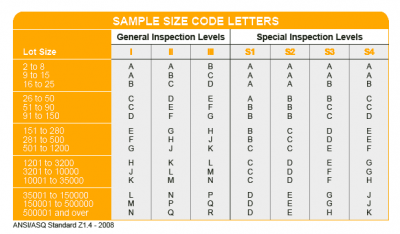 AQL Table | How to Read It
AQL Table | How to Read It TOP 10 Common Defects in Garments Quality Inspection
TOP 10 Common Defects in Garments Quality Inspection Product Packaging and Shipment Label requirements for Amazon FBA
Product Packaging and Shipment Label requirements for Amazon FBA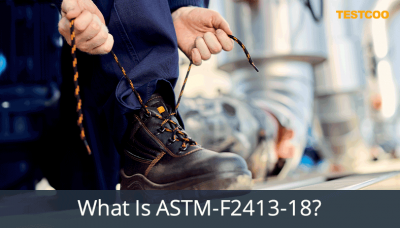 What Is ASTM-F2413-18? Protective Footwear Standard
What Is ASTM-F2413-18? Protective Footwear Standard How to Conduct Third-Party Quality Control Inspections for Electric Scooters
How to Conduct Third-Party Quality Control Inspections for Electric Scooters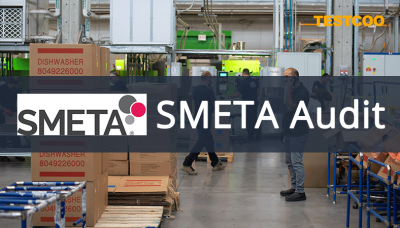 SMETA Audit-What is SMETA Audit?
SMETA Audit-What is SMETA Audit?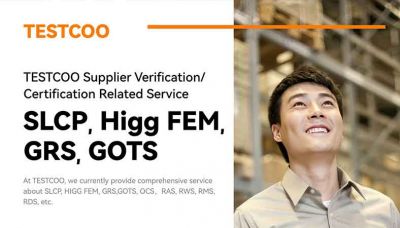 TESTCOO Supplier Verification/Certification Service SLCP, Higg FEM, GRS, GOTS
TESTCOO Supplier Verification/Certification Service SLCP, Higg FEM, GRS, GOTS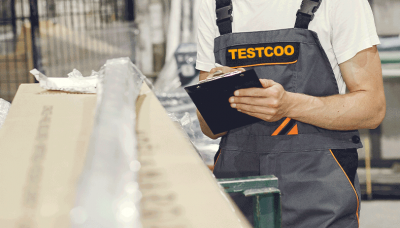 Quality Control Inspection Company in China
Quality Control Inspection Company in China What is Quality Inspection? A Complete Guide
What is Quality Inspection? A Complete Guide Guidelines for Product Inspection in India
Guidelines for Product Inspection in India
Category
- Production Inspection Service
- Factory Audit
- Softline Inspection
- Hardline Inspection
- Electrics Inspection
- Certification
- Checklist
- Manufacturers
- Quality Assurance Basics
- Products Recall
- AQL
- Guidence and Standard
- News
- Supplier Management
- Amazon
- Protective Equipment
- e-commerce quality control
- Indian Manufacturing
- Soft Goods Quality Control
- Supply Chain Management
- Supply Chain Resilience
- E-Commerce Quality Control
- ISO 2859
- Supply Chain Optimization
- Garment Industry
- Higg Index



